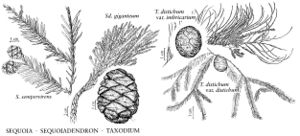Taxodium
Ann. Mus. Natl. Hist. Nat. 16: 298. 1810.
| Taxon | Illustrator ⠉ | |
|---|---|---|
 | Sequoiadendron giganteum Sequoia sempervirens Taxodium distichum var. imbricarium Taxodium distichum var. distichum | John Myers John Myers John Myers John Myers |
Trees deciduous or evergreen. Branchlets terete. Lateral roots commonly producing erect, irregularly conic to rounded knees in periodically flooded habitats. Leaves alternate, in 2 ranks or not. Adult leaves divergent to strongly appressed, linear or linear-lanceolate to deltate, generally flattened, free portion to ca. 17 mm; abaxial glands absent. Pollen cones with 10–20 sporophylls, each sporophyll with 2–10 pollen-sacs. Seed-cones maturing and shattering in 1 season, nearly globose; scales falling early, 5–10, valvate, ± peltate, thin and woody. Seeds (1–) 2 per scale, irregularly 3-angled, wingless; cotyledons 4–9. x = 11.
Distribution
North America, Mexico, Central America in Guatemala
Discussion
The pollen cones are usually borne at the base of alternate leaves, forming pendent axillary panicles; they occur less commonly singly or in racemes.
Taxodium is variously treated as one to three species but treated here as one polymorphic species with two varieties in the flora. A third taxon tentatively accorded varietal rank--- Taxodium distichum (Linnaeus) Richard var. mexicanum Gordon (= Taxodium mucronatum Tenore)—and recognized by some authors as occurring within our range, appears to differ only in minor phenological characters. Whether or not populations from farther south in Mexico and Guatemala differ sufficiently for formal taxonomic recognition at any rank has yet to be determined.
Species 1(–3) (1 in the flora).
Selected References
Lower Taxa
"thin" is not a number.